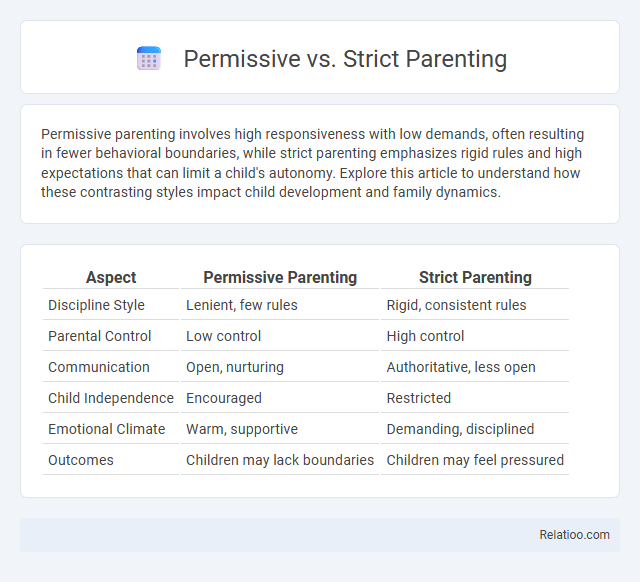Permissive parenting involves high responsiveness with low demands, often resulting in fewer behavioral boundaries, while strict parenting emphasizes rigid rules and high expectations that can limit a child's autonomy. Explore this article to understand how these contrasting styles impact child development and family dynamics.
Table of Comparison
| Aspect | Permissive Parenting | Strict Parenting |
|---|---|---|
| Discipline Style | Lenient, few rules | Rigid, consistent rules |
| Parental Control | Low control | High control |
| Communication | Open, nurturing | Authoritative, less open |
| Child Independence | Encouraged | Restricted |
| Emotional Climate | Warm, supportive | Demanding, disciplined |
| Outcomes | Children may lack boundaries | Children may feel pressured |
Introduction to Parenting Styles
Parenting styles significantly impact child development, with permissive parenting characterized by high responsiveness and low demands, allowing children considerable freedom. Strict parenting emphasizes high demands and low responsiveness, enforcing rules and discipline to shape behavior. Understanding the distinctions between permissive and strict approaches helps parents balance warmth and control to support healthy emotional and social growth.
Defining Permissive Parenting
Permissive parenting is characterized by high responsiveness and low demands, where parents are indulgent and avoid setting firm boundaries or enforcing consistent rules. This style contrasts with strict parenting, which emphasizes discipline, structure, and clear expectations to guide children's behavior. Permissive parents prioritize their child's freedom and self-expression over control, often resulting in less regulated behavior and decision-making autonomy for the child.
Characteristics of Strict Parenting
Strict parenting emphasizes high expectations, consistent discipline, and clear rules to guide children's behavior and development. Your child may experience structured routines, limited freedoms, and frequent monitoring to foster responsibility and self-control. Unlike permissive parenting, which prioritizes warmth and flexibility, strict parenting focuses on obedience and accountability through firm boundaries.
Key Differences Between Permissive and Strict Parenting
Permissive parenting is characterized by high responsiveness and low demands, often resulting in fewer rules and greater freedom for children to explore, whereas strict parenting involves high demands and rigid rules with less emotional flexibility. The key differences lie in disciplinary approaches: permissive parents tend to avoid confrontation and enforce minimal discipline, while strict parents emphasize obedience and consistent consequences. These contrasting styles significantly impact a child's self-discipline, social skills, and emotional regulation.
Psychological Effects on Children
Permissive parenting often leads to children exhibiting higher levels of impulsivity and lower self-discipline due to lack of boundaries, while strict parenting can result in increased anxiety and reduced social competence from excessive control. Children raised with a balanced approach that combines warmth and clear guidelines tend to develop better emotional regulation and resilience. Psychological effects vary widely depending on the consistency and emotional quality of parental involvement rather than the strictness alone.
Academic and Social Outcomes
Strict parenting often correlates with higher academic achievement due to clear rules and expectations, fostering discipline and responsibility in children. Permissive parenting tends to result in lower academic performance but may promote creativity and social competence by allowing greater autonomy. In social outcomes, strict parenting may lead to obedience yet possible social withdrawal, whereas permissive parenting supports social skills but can result in difficulties with authority and self-regulation.
Long-term Impacts on Child Development
Permissive parenting, characterized by high responsiveness and low demands, often leads to children with lower self-discipline and potential behavioral problems, whereas strict parenting with high demands and low responsiveness can foster obedience but may induce anxiety and lower self-esteem. Balancing aspects of both styles tends to promote healthier long-term child development, with increased emotional regulation and social competence. Research highlights that overly permissive approaches may delay the development of responsibility, while overly strict approaches risk hindering autonomy and critical thinking skills.
Cultural Influences on Parenting Styles
Cultural influences significantly shape permissive and strict parenting styles, with permissive parenting often emerging in individualistic societies that value autonomy and self-expression, while strict parenting is more prevalent in collectivist cultures emphasizing obedience and family hierarchy. Research indicates that Asian and Latin American cultures frequently adopt strict parenting to instill respect and discipline, whereas Western cultures lean toward permissive approaches promoting independence. Understanding these cultural dynamics is crucial for appreciating how parenting practices vary globally and impact child development.
Finding a Balanced Approach
Finding a balanced approach between permissive and strict parenting involves setting clear boundaries while allowing flexibility for your child's individuality to flourish. Your child benefits most when parental guidance combines structure with empathy, fostering responsibility without stifling creativity. Integrating consistent rules with open communication ensures a nurturing environment where emotional growth and discipline coexist effectively.
Conclusion: Choosing the Right Parenting Style
Choosing the right parenting style depends on your child's unique needs and temperament. Permissive parenting fosters creativity and independence but may lack boundaries, while strict parenting emphasizes discipline and structure but can limit emotional expression. Balancing flexibility with clear expectations ensures your child develops confidence and responsibility.

Infographic: Permissive vs Strict Parenting
 relatioo.com
relatioo.com